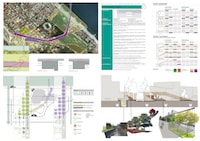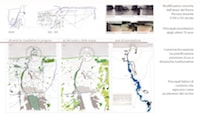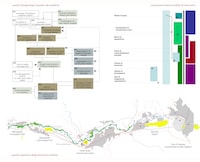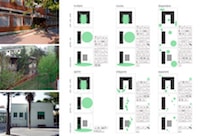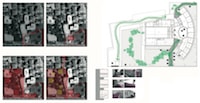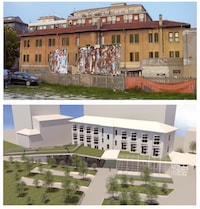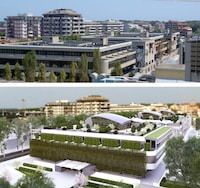Il rapporto tra Sostenibilità e Innovazione tecnologica nella progettazione dell’ambiente urbano a cura di Filippo Angelucci
torna su
Technological innovations for the regeneration of urban space qualities *
Filippo Angelucci, Antonio Basti, Cristiana Cellucci, Michele Di Sivo, Daniela Ladiana
Filippo Angelucci, Antonio Basti, Cristiana Cellucci, Michele Di Sivo, Daniela Ladiana
Abstract:
The sustainable future of all urban settlement systems is seemingly bound to depend on our reasonableness in employing technical innovations in order to implement an integrated process of regeneration of the multiple heritages which we inherit from the history of cities. This process may only acquire organic features of qualification and requalification of the urban system if it is based on the construction of technological consistencies between strategic, tactic and operational scale. By setting interventions to take care of, maintain, make accessible and safe the existing local natural and artificial heritage, it is possible to extend the useful life cycle of urban settlement and increasing its value for future generations.
ERC Keywords
PE8-10 Production technology, process engineering
PE8-12: Sustainable design (for recycling, for environment)
SH3-1: Environment, resources and sustainability
SH3-9: Spatial development, land use, regional planning
SH5-11: Cultural heritage, cultural memory
1. For a regenerative technological innovation of the city
The evolution and retention of the quality level of urban settlement systems are today increasingly biased by the poverty of material, economic and energy resources, often matched by a lowering of the city life quality levels, in terms of external micro-climate conditions, safety and accessibility of resources and services.
Despite the emphasis of the media in defining the weaknesses of contemporary cities as consequences of the cultural globalization and the repeated economic recessions of the last decades, such a scenario may only partly be defined as the outcome of the worldwide liberalization processes of financial markets or the so-called “Great Recession” triggered since 2009. On the contrary, we should reread the current phase of evolution of the cities and their “unsustainability” as a loss of the meaning of urbanity resulting from the crisis of knowledge, models and design and building practices which, after the second world war, have progressively fuelled the unreasonable use of natural and artificial capital by individual citizens as well as entire communities. According to this definition of the concept of crisis, the innovations achieved in the various technical sectors have remarkably contributed to address the cities development dynamics and to intensify resource consumption. As claimed by Mauro Bonaiuti, referring to the “paradox of well-being”, the same idea of buildings and cities as concentrations of increasingly innovative and high-efficiency technical solutions, while reducing consumption (and thus acting in favour of sustainability), also generates new needs and activates increasingly high sets of requirements (Bonaiuti, 2005).
In a systemic-holistic vision of the city that goes beyond the concept of technique as mere instrumental resource at the service of quantitative production dynamics, stocks of biophysical, socio-economic, cultural and anthropic resources come into play and interact (Ciribini, 1971), (Guazzo, 1984), configuring urban systems as metabolic organisms. The city should be seen as a built environment, understood as a place where the possible dynamic levels of retention of the quality conditions of well-being are created, where to look for and put in practice the reasonable use of techniques at the service of inhabitants and their habitat (Vittoria, 1975). A place where it is possible to actually re-establish a new relationship between nature, humankind and techniques (Boaga, 1976) and mark the passage from production rationality to reasonableness of the “care” of the city (Emery, 2007) (Pope Francis).
If we linger on the idea of built environment and on the responsibilities of techniques in the building processes of human habitat, the relationship between innovations and sustainability of the cities is reconfigured as a continuous technological-environmental, inter/trans-disciplinary design research into which managerial, curative, economic, legislative knowledge and practices converge (Griffith, 2004) (Chynoweth, 2009).
In this respect, the weaknesses that seem to affect all urban settlements may be dealt with and solved restarting from a reflection on the (existing, interrupted or new) relationships between soft and hard technologies for the transformation and management of the built environment. The system “city” with its housing, cultural, social and economic processes which characterize living the city together, can be re-thought in a new glocal/lobal combination (Robertson, 2007), (Scudo, 2014), (Bonomi, 2014).
The scientific position of the BETHA1 research group when dealing with the issues of sustainability, technological innovations and quality levels in the building and management processes of the built environment at various scales of intervention may be defined as above. In the urban setting, these issues are bound to play an increasingly large role in scientific research and design, to start a new season of technologies for the built environment as regenerative technologies for the city and its multiple heritages. These capitals – inherited from our past and projected to the future – require approaches, tools and experimental solutions that are able to regenerate urbanity, restarting from maybe forgotten assumptions on the evolutionary relationships between technological innovations, nature, individuals, companies (Jantsch, 1969 ), (Ciribini, 1971). For this change of direction, it is necessary three different dimensions of the green culture, to quote Felix Guattari, looking for new and inextricable green reasons for building a city from an environmental, social and mental perspective (Guattari, 1989).
2. On appropriateness and deviance: three new guidelines for urban quality
If in order to turn the current unsustainability of the city into regenerative opportunities for its spaces, users and communities it is necessary to refer to a new relationship between technologies, nature, individuals, companies and products, technological innovations shall play a different role in defining the quality of the urban built environment. The same idea of urban quality should be redefined through new keywords that are able to give momentum to experimental research and design, to address what prefigures as an actual phase of transition towards new and unpredictable forms of urbanity.
The same technology-nature, technology-individual, technology-society and technology-products combinations, albeit fundamental for understanding and solving the increasingly complicated problems and weaknesses of contemporary2 cities, are no longer enough when you have to look at the city as a varying and ever-evolving organism. As Mario Zaffagnini explained in his reflection on the meaning of city quality, urban quality does not come from specific conditions, taken separately, but it is a set of all and many other conditions whose systemic identification is difficult, because they are not always easily identifiable and constant in time (Zaffagnini, 1980).
The new technological challenge is the reinterpretation of the problematic issues of the process of planning, realizing and managing the city organism – in a dynamic and inter-systemic key – toward a broader and more balanced relationship of the technological innovations with: the ecological-metabolic abilities of the natural systems, the well-being and health of individuals, the effectiveness of the activities of socio-collective systems, the efficiency, and the performance abilities of the technical-construction systems.
A potential field of reinterpretation of the relationship between technological innovations and urban quality may be identified restarting from the varying relationship that innovations shall now establish with the contemporary technical-cultural settings in which they act, characterized by an increasingly less marked recognisability of exogenous-global (market, political, financial, economic, climate) aspects and endogenous-local (production, cultural, administrative, religious, geographical) aspects.
This varying relationship today faces two re-emerging concepts that in the past seemed to only gain value by contrast between highly technical-scientific developed industrial realities and developing and industrializing countries based on which it should be reread and governed:
- the concept of appropriateness of technological innovations, understood as interrelation ability between development, contextual situations and local resources (Amirante, 1992), no longer seen as a set of “poor/intermediate” solutions, but as a system of interventions to interpret the requests for transformation of the city, starting from pre-existing, unique and different situations that now characterize all post-industrial urban environments (Gangemi, 1985);
- the concept of deviance of technological innovations, referred to the ability to integrate the complexity of natural elements and their metabolic processes in the functional and housing dynamics of the urban space (Vittoria, 1988). The concept of technological deviance is today necessary to trigger new skills, abilities, performances, and levels of adaptation of the products as well as the inhabitants, to face the present and future emergencies of the city.
In this varying view that portrays instability of contemporary cities, likely bound to take increasingly variable configurations to support the unpredictable dynamics of change, the objective of urban sustainability is already intrinsically difficult to reach and should adopt new parameters of quality control to govern the processes of technical innovation and use of resources. These parameters may not only help determine crystallized and unmovable answers but also strategies, tactical scenarios and open solutions that are able to follow through the transition of the city as we have considered it to date, towards an idea of the city yet to be defined.
In this respect, urban quality is not just considered as the ability of technical solutions to be exactly compliant with specific, measurable “once and for all”, localized problems but as the ability to weave multi-scale relationships and activate reversible and always re-directable space-time connections between compatible usages and available resources. These new technological guidelines for urban quality may be related to three main but not exclusive interrelation fields:
- the qualities of adaptation and evolution, related to the conditions of use to be facilitated in the transformation and management of city spaces which may enable adaptation abilities of individuals, communities and products in order to face sustainably and resiliently both the extraordinary and emergency variability of urban organizations while ensuring the evolution and reproducibility of the natural biophysical systems and their processes;
- the qualities of care and retention, related to the conditions of use which may favour the activities of continuous care and efficiency of urban resources, healthiness, safety and habitability of housing spaces while ensuring the retention and improvement of the physical and psycho-cognitive abilities of the inhabitants with their different abilities, cultures and needs;
- the qualities of cycle and supply chain, concerning the conditions of use of the city and of its natural and artificial components which may facilitate the aware and inclusive use of existing resources (e.g. limitation of soil consumption, regenerative motility of natural apparatuses, energy production from renewable sources). The quality of cycle/supply chain is necessary to develop virtuous and innovative relationships between the inhabitants, spaces and processes of the urban system.
On the appropriate/deviant use of technological innovations and on these three applications of urban quality, the BETHA group has started specific research activities and study initiatives, also in partnership with “other” disciplinary sectors that may positively contribute to the regenerative process of the cities.
3. Approaches, tools and regenerative technological actions on the city
The systemic environmental and resources crisis of contemporary settlement systems – from the smaller cities to the large metropolitan agglomerations – is the main activity sector of the BETHA research group to experiment studies and targeted proposals to turn the current levels of unsustainability of inhabiting processes into the opportunity to adapt spaces, users and products to the changes under way. The current research activities linger on the possibility to intervene on the technical and spatial elements of the urban built environment, in the short, medium and long term, through methods, tools and city-regenerative technological actions.
This integrated, planning, proactive and implementing design activity is not limited to single phases or sectorial themes of intervention, but has an inter-systemic, inter-dimensional and inter-scale character. The BETHA group’s current (and new) research is characterized by the same objective, i.e. facing three new emerging challenges of the technological-environmental design of the city system and its components (buildings, blocks, infrastructures, districts, open spaces):
- a process vision of regenerative policies/actions of the urban environment (energy issues, alternative scenarios, life cycles of the system), operating at different levels of intervention, spatial settings, times and users;
- a performance vision of interventions (levels of evaluation, qualitative-quantitative tools for adjustment of the system performances) to coordinate the regenerative processes, including planning, scheduling, implementation and management;
- a relational vision, aimed at the integrated design of new spaces of relationship to enable innovative formats of production, use and consumption of human resources.
With respect to these visions, the study and experimentation activities of the BETHA group on the relationship between technological innovations and sustainability of the urban environment may be included in three settings: the new paradigms of resilience and inclusion in the city regeneration project; the culture of maintenance and safety for the managing of urban quality; the recovery, enhancement and management of the public real estate heritage with a view to reduce soil consumption.
3.1 Resilience and inclusion in the city regeneration project
Waiting to get out of a recession phase that is seemingly bound to protract for a long period, the issue of the relationship between technological innovations and ecological, economic and social sustainability of the urban settlement systems will have to face a brand new problem. It is the assignment of new functions and new value to the existing (natural, artificial, human) resources of the city, way before providing for new formats of expansion and construction.
A radical change of route of the project objectives of the city space is necessary; the project shall first be rethought through targeted intervention to recognize and emphasize the abilities of resilience and inclusion3 of actually available resources. It will be then necessary to reconnect the natural and anthropic components of the settlement system to recognize residual abilities (Di Sivo and Angelucci, 2012) and abilities to ‘support’ urban quality and face changes (some of which are still not fully predictable) of weather, society, economy and culture (Angelucci, Cellucci, Di Sivo, Ladiana, 2015).
Working on the resilience and inclusion abilities of the city organism means processing inter-scale design responses (at a strategic, tactical and operational level) which may take variable and reversible configurations in the short, medium and long term. Resilience and inclusion can facilitate to meet the needs of different categories of users and to be able to accommodate and integrate multiple skills, abilities, citizenships and creativities in the urban regeneration process.
In this respect, some of the experiences of the BETHA group (DeLiCIA, Designing Livable City for All; experimentations on the systems of the river areas of the Pescara valley) have been aimed at identifying conditions, requirements, performances and solutions to regenerate vitality and liveability of the urban system (Angelucci and Di Sivo, 2013) (Angelucci, Di Sivo and Ladiana, 2014) (Figg. 1, 2 e 3).
Technological innovations assume a specific enabling/capabilitating feature which goes beyond the quantitative vision of the project and operates on the integrated qualities of spaces, natural/artificial components, buildings, infrastructures and technical elements, by emphasizing: the responsiveness, metabolic-environmental evolution and connection, organizational-procedural adaptability and inclusiveness, transformability, flexibility and technological-spatial accessibility (Angelucci, Di Sivo and Ladiana, 2013).
3.2 Maintenance and safety for the managing of urban quality
Since social, economic and physical-environmental aspects coexist and co-evolve in the city, the scheduling of any transformation or retention activity should aim to the maximum possible integration of said aspects if it intends to achieve a real effectiveness of interventions in the retention and improvement of urban qualities.
The need to detach from the traditional policies of emergency management of the effects prompted by the obsolescence and degradation of urban systems, today requires a substantial change both of the planning strategies aimed at pursuing sustainability, and of the operating actions on the city heritage so that it can be passed on to the future generations of inhabitants. It is necessary to work for the achievement of urban efficiency looking at the city as a heritage to take care of, keep safe and improve its performance in terms of liveability and habitability. Taking urban efficiency as the objective of the project for the maintenance and safety of the city implies a systemic scheduling of the design actions. So that they are not only aimed at the retention of a plurality of objects that make up the urban system, but also to guarantee the permanence/improvement of the services supplied by the system as a whole (Di Sivo, 2004).
The experiences of the BETHA group for the sharing of school spaces (Angelucci, Di Sivo and Ladiana, 2013) and for the creation of district labs for the care and maintenance of the city (Di Sivo and Ladiana), show the possibility to re-read the technological innovations as precious resources to supply adequate services to meet new requests of the inhabitants of contemporary cities (Figg. 4, 5 e 6).
The care, safety and maintenance of the city are seen in a brand new light. Not just as strategies for the repair, adjustment, replacement of components or parts of the urban system, but as actions that – by facilitating new uses and functions for the city resources and a coordinated process of participated and shared design of common spaces – progressively create the conditions to extend the concept of sustainability to social, economic and cultural aspects of living together.
3.3 Recovery, enhancement and management of the public real estate heritage
The topic of the management and enhancement of the underused public real estate heritage may represent one of the significant actions for a hoped-for and progressive mitigation of the ecological footprint of the built environment. The recovery and re-use of the pre-existing housing facilities – in addition to representing an environmental advantage related to the lesser need to build new buildings and infrastructures – also gives a glimpse of the possibility to trigger virtuous processes of requalification of buildings and parts of cities, otherwise subject to degradation and abandon4 (Fig.7).
The feasibility of these processes depends on the correct composition of a complex series of elements. They include the identification of the potential ‘vocations’ and the relevant scenarios of reuse of the goods, the formulation of the implementation methods of the interventions (direct management, agreement for use, sale), the development of the controlling tools for the achievement of public5 utility (AA.VV., 2014). After all, the latest legislative developments on the subject6 have progressively identified real estate heritage planning and management tools aimed at combining the topic of 'real estate enhancement’ with local development, to systematize the local “territorial capital” (Truppi, 2012). The achievement of said objective however presumes the right legislative, regulatory and technical-procedural tools to allow for the managing of decision-making and implementing planning processes. These processes often need to combine the requirements of the public bodies that own the goods and the requirements of the private parties who are interested in investing in enhancement initiatives (Tronconi, 2012).
Whatever the scenario or the alleged enhancement procedure (Ascioni, 2013), the need for a number of activities is clear. These activities aim to “learn” and analyze the real estate heritage (dimensional, functional, working, structural, energy, technological and plant engineering and management (Fig. 8) (De Santoli, 2010) characteristics), to formulate a value assignment in order to start public-private consultation processes and proceed to define reuse and requalification scenarios7 as shared as possible among local communities8.
In this respect, the activities of the BETHA group in the sector of school heritage maintenance and management (Di Sivo, 2012) and energy requalification of university building heritage (Basti et al., 2012) have defined solutions to support the recovery and enhancement processes of existing buildings.
4. The horizons of technological innovation for the cities of the future
The interpretation of technological innovations in a curative/regenerative key that is being brought forward as part of the activities of the BETHA group can become especially important and central in the process of retention, care, safety implementation and requalification of the physical resources of the city. It is high time to rethink technologies to build in a comprehensive and inter-scale fashion which allows us to reconnect the planning aspects of the transformational processes of the city in a circle of technical-constructive consistencies with the sharing and approval of interventions, up to the more strictly implementing and site-related aspects.
In this respect, one of the main horizons of innovation that are present in this broadened technological vision of the project is the re-location of the discipline of architectural technology in a new role – yet to be investigated – to support the city management, modification and regeneration processes.
Technologies, rather than colonizing spaces and soils, will have to ensure consistencies and continuity in the definition of urban quality, at the different levels of intervention and during the possible future seasons of retention and/or transformation.
Technological innovations will play a new and dual role, technical-material and informational-immaterial role. They will be asked to meet the requirements of the inhabitants and the changes in their behaviors, to recognize the abilities and adaptation conditions of the settlement system, to guarantee the renewability of resources and their sustainable use, to favour, nurture and develop new and alternative abilities and functionalities to experience the city. In short, to manage the various aspects of the evolution of the urban space in line with available resources, allowing management, economic, legislative and technical knowledge to coexist in the design of city.
Notes
* This paper is a result of reflections of the authors made as part of the activities of the BETHA group. In particular, F. Angelucci is the author of paragraphs 1 and 2; F. Angelucci, A. Basti, C. Cellucci, M. Di Sivo and D. Ladiana have written paragraphs 3 and 4; F. Angelucci, C. Cellucci, M. Di Sivo and D. Ladiana are the authors of paragraph 3.1; M. Di Sivo, D. Ladiana, F. Angelucci and C. Cellucci are the authors of paragraph 3.2; A. Basti is the author of paragraph 3.3.
1. Established in 2012 at the Department of Architecture of the University of Chieti-Pescara, as part of the PAr (Patrimonio Architettonico/Architectural Heritage) section, the BETHA research group – Built Environment Technologies and Healthy Architectures, made up of professors and researchers coming from the disciplinary scientific sector ICAR/12 (Technology of Architecture). It positions its scientific and experimental activities in the field of technological design and management for the built environment in view of interdisciplinary research on the themes of innovation of building processes, sustainable transformation of anthropic habitat, recovery and regeneration of the built heritage, to the housing, urban and territorial scale.
2. Even if their global impacts and compatibility with local space-territorial organizations are not yet fully investigated, said relational fields have still allowed for a broadening of the managing of technological innovations in the sector of the transformations of the city, guiding the objectives of architectural and urban quality to the directions of ecological, social, economic and energy sustainability, in terms of performance and so that they are objectively verifiable.
3. In this field of experimentation the relationship between technological innovations and urban design refers to two emerging concepts: resilience, understood as the dynamic adaptation and reorganization ability of a complex bio-psycho-social-ecological system such as the city to any changes; inclusion that, according to the World Health Organization’s ICF, allows to re-read any housing space that is able to include or exclude people, enabling or inhibiting their functional, emotional, physical-motor and cognitive abilities.
4. For this aspect, the awareness-raising campaign RI.U.SO., RIgenerazione Urbana Sostenibile – sustainable urban regeneration, launched in 2012 by Italian CNAPPC (National Council of Architects, Planners, Landscapers, Conservators), ANCE (National Association of Housing developers) and Legambiente has been especially significant.
5. From this point of view the Italian Code of cultural heritage and landscape (Legislative Decree 42/2004, art. 111) identified integrated enhancement of the territory as one of the essential methodological and operational tools for the purposes of promotion and support of economic development of local communities, knowing that the enhancement of cultural heritage is pursued through the “[…] creation and establishment of resources, structures or networks, or the availability of technical skills […]”.
6. Italian Law no. 410/2001 (Conversion in law of legislative decree no. 351/2001); law decree no. 201/2011, (converted in law no. 214/2011) which introduces in Law 410/2001 PUVaT (unit programs of territorial enhancement) which albeit aimed at the managing of territorial initiatives, identify the promotion, coordination and support of processes of function implementation and enhancement of real estate owned by the State, territorial entities and other public bodies as final objective. That is both to guarantee a better rationalization of the use of public real estate facilities and to boost new formats of public-private partnership oriented to the inclusion of the interest of the market and of the entrepreneurs in view of the regeneration of degraded urban settings. Visit the following website: www.agenziademanio.it/opencms/it/notizia/PUVat-Bologna, to read about the experience of the State Property Office with reference to the City of Bologna.
7. The main aspects required to define the scenarios of recovery and enhancement include: technical-economic (functional, typological, technological requirements), financial and administrative feasibility; the preparation of regulatory and supervisory tools and procedures for transparency and the quality assurance of the project, the building and the management of the works; the criteria for a “better and compatible” management of the works with the essential requirements of protection of the rights of the community.
8. Special reference is made to the objectives of community-led local development established by articles 32, 33 and 34 of Regulation (EU) 1303/2013 and governed through the formulation of the “Strategies of community-led local development” and the “Leader” method which entrusts processes governance to the “Community-Led Local Development (CLLD)”.
Authors
Filippo Angelucci, Architect, PhD on Environmental Design, is Researcher on Architectural Technology of the “G. d’Annunzio” Chieti-Pescara University here carries out his research and teaching activity. He is the author of books essays and publications on technological and methodological innovations for the environmental design at landscape, urban and building scale.
Antonio Basti, Architect, is Assistant Professor in Architectural Technology at the Department of Architecture, University "G. D'Annunzio " of Chieti-Pescara, where carries out his research and teaching activity. He is author of many studies and publications about the environmental sustainability of materials and building elements, and about the methods and tools for the enhancement, the energy requalification, and the healthy of existing buildings.
Cristiana Cellucci, Architect, Ph.D. on Building Technology and Environment, research fellowship on Architectural Technology of the “G. d’Annunzio” University of Chieti-Pescara.
Michele Di Sivo, Architect, is Full Professor on Architectural Technology of the “G. d’Annunzio” University/Department of Architecture. He is Director of post-graduate courses on maintenance and management of architectural heritage and building materials. He is member of the Italian Maintenance Association (A.I.MAN) and author of books and publications building maintenance and safety themes.
Daniela Ladiana, PhD on Technological Culture and Environmental Design, is Researcher on Architectural Technology of the “G. d’Annunzio” Chieti-Pescara University. She carries out activities in the field of maintenance and safety of building system. She has published books, essays and articles in specialist journals on safety and maintenance of the built environment
Bibliographical references
AA. VV., (2014), “Strategie e strumenti di valorizzazione del patrimonio immobiliare pubblico”, Agenzia del Demanio, consultabile on line al sito. www.agenziademanio.it.
Amirante I., (1992) “L'evoluzione della ricerca per le tecnologie ambientali”, in Gangemi V., a cura di, Cultura e impegno progettuale. Orientamenti e strategie oltre gli anni '90, FrancoAngeli, Milano, IT.
Angelucci F., Cellucci C., Di Sivo M., Ladiana D., (2015), “Qualità misurabile e qualità vissuta della città. La rigenerazione urbana come riconnessione tecnologica tra risorse, spazi, abitanti, in TECHNE Journal of Technology for Architecture and Environment n°10/2015, in stampa, Firenze University Press, Firenze, IT.
Angelucci F., Di Sivo M. (2013). “Resilienza e qualità dell’ambiente costruito tra vulnerabilità e nuovi valori. Il ruolo della progettazione tecnologica. Resilience and Quality of the Built Environment between Vulnerabilities and New Values. The Role of Technological Planning”. Utopie e Distopie nel Mosaico Paesistico-Culturale. Visioni Valori Vulnerabilità. Atti della Conferenza Scientifica Internazionale 27-28 giugno 2013/Utopias and dystopias in landscape and cultural mosaic. Visions Values Vulnerability. Proceedings of the International Scientific Conference June 27th-28th 2013, Sabiedriba, Integracija, Izglitiba Forum, 91- 102, vol. IV, Publisher Rezekne Higher Educ Inst-Rezeknes Augstskola, Rezekne, LT.
Angelucci F., Di Sivo M., Ladiana D. (2014), “Tra il fiume e la città. Resilienza VS vulnerabilità nei sistemi insediativi di ambito fluviale” in TECHNE Journal of Technology for Architecture and Environment, n°07/2014, p. 94-100, Firenze University Press, Firenze, IT.
Angelucci F., Di Sivo M., Ladiana D., (2013/1), “Reattività, adattabilità, trasformabilità: i nuovi requisiti dell'ambiente costruito”, in TECHNE Journal of Technology for Architecture and Environment n°05/2013 “Emergenza Ambiente/Environment Emergency”, IT, Sez. Saggi, pag. 53-59, Firenze University Press, Firenze, IT.
Angelucci F., Di Sivo M., Ladiana D., (2013/2), “La scuola oltre la scuola. La gestione degli spazi scolastici tra rigenerazione e condivisione delle risorse”, in TECHNE Journal of Technology for Architecture and Environment n°6/2013, Firenze University Press, Firenze, IT.
Ascioni S., (2013), La procedura di dismissione del patrimonio pubblico immobiliare, Exeo Edizioni, IT.
Basti A., Pardi G., Lucci A., (2012) Valorizzazione e riqualificazione del patrimonio pubblico tra efficienza energetica e fonti rinnovabili, TECHNE Journal of Technology for Architecture and Environment, n°3-2012, Firenze University Press, Firenze, IT.
Boaga, G., De Rossi, A., (1976) Problemi di recupero dell'habitat, Seminario a Cartagena de Indias – Repubblica di Colombia, 4-8 ottobre 1976, Roma, IT.
Bonaiuti M., (2003) Bioeconomia. Verso un’altra economia ecologicamente e socialmente sostenibile, Bollati Boringhieri, Torino, IT.
Bonomi, A. (2014) “Pensarsi tra smart city e smart land” in Bonomi, A., Masiero, R., Dalla smart city alla smart land, pp. 16-18, Marsilio, Padova, IT.
Chynoweth, P., (2009) “The built environment interdiscipline: A theoretical model for decision makers in research and teaching”, in Structural Survey, Vol. 27(4), pp. 301-310.
Ciribini G., Crespi R., Guarnerio G., (1970) Politica, habitat, nuova tecnologia – Prospettive di pianificazione sistemica, Ente Fiera di Bologna, Bologna, IT.
Ciribini, G., (1971) Un pianeta da abitare - requisiti e prestazioni per l'ambiente costruito, Ente Autonomo Fiera di Bologna, Bologna, IT.
De Santoli L., (2010) La gestione energetica degli edifici. Flaccovio Editore, Palermo, IT.
Di Sivo M., (2012) “La gestione del patrimonio scolastico: l’esperienza dei comuni di Porto e di Matosinhos”, in TECHNE Journal of Technology for Architecture and Environment, n°3-2012, Firenze University Press, Firenze, IT.
Di Sivo M. (2004), Manutenzione urbana. Strategia per la sostenibilità della città, Alinea, Firenze, IT.
Di Sivo M., Angelucci F. (2012). “Un approccio tecnologico per l’ambiente urbano resiliente A technological approach for a resilient urban environment”. Abitare il nuovo/abitare di nuovo ai tempi della crisi, Atti delle Giornate Internazionali di Studio "Abitare il Futuro" 2a Edizione, Napoli, 12-13 dicembre 2012 CLEAN, Napoli, 1625-1635, In:Abitare il Nuovo, Abitare di Nuovo. 12-13 dicembre 2012, Napoli, IT.
Emery, N. (2007), Progettare, costruire, curare: per una deontologia dell'architettura, Edizioni Casagrande, Bellinzona, CH.
Gangemi V., (1985) “Tecnologie appropriate per l'abitare”, in Gangemi V., a cura di, Architettura e tecnologia appropriata, FrancoAngeli, Milano, IT.
Griffiths, R., (2004) “Knowledge production and the research-teaching nexus: the case of the built environment disciplines”, Studies in Higher Education, Vol. 29(6), pp. 709-26.
Guattari, F., (1989), Les trois écologies, Éditions Galilée, Paris, F.
Guazzo G., (1984) Progetto e qualità ambientale. Abitare e costruire in un campo di variabilità, Veutro, Roma, IT.
Jantsch, E. (1969) “Perspectives of planning”, OECD Publications Center, Washington D.C., USA.
Papa Francesco, (2015), Laudato Sì. Lettera enciclica sulla cura della casa comune, pp.143-158, Edizioni Piemme, Roma, IT.
Robertson, R. (2007) “I limiti della globalizzazione: la glocalizzazione e le sue forme”, in La vita in bilico. Suspense del mondo: uomo e natura innanzi alla virtualità, sviluppo equilibrato, comune causa delle responsabilità, Atti della XXXII edizione delle Giornate Internazionali di Studio Centro Pio Manzù, pp. 109-206, Centro Ricerche Pio Manzù, Strutture ambientali, Rimini, IT.
Scudo, G. (2014) “Per una tecnologia dell’architettura bioregionale” in AA. VV., La cultura tecnologica nella scuola milanese, pp.178-185, Maggioli Editore, Rimini, IT.
Tronconi O., Manfredi L., (2012), La valorizzazione immobiliare, Metodi e progetti, Maggioli, Rimini, IT.
Truppi C., (2012) “Tutela e valorizzazione del patrimonio territoriale”, in TECHNE Journal of Technology for Architecture and Environment, n°3-2012, Firenze University Press, Firenze, IT.
Vittoria E., (1975) Argomenti per un corso di tecnologia dell’architettura, Multigrafica Brunetti, Roma, IT.
Vittoria E., (1988) “Le tecnologie devianti in architettura”, in Fabbri M., Pastore D., a cura di, Architetture per il terzo millennio. Una seconda rivoluzione urbana?, Fondazione Adriano Olivetti, Roma, IT.
Zaffagnini M., (1980) “Prefazione” in Lombardi E.: “Modelli abitativi e utenza: l’esperienza danese. La lunga strada verso la qualità urbana”, BE-MA Editrice, Milano, IT.

